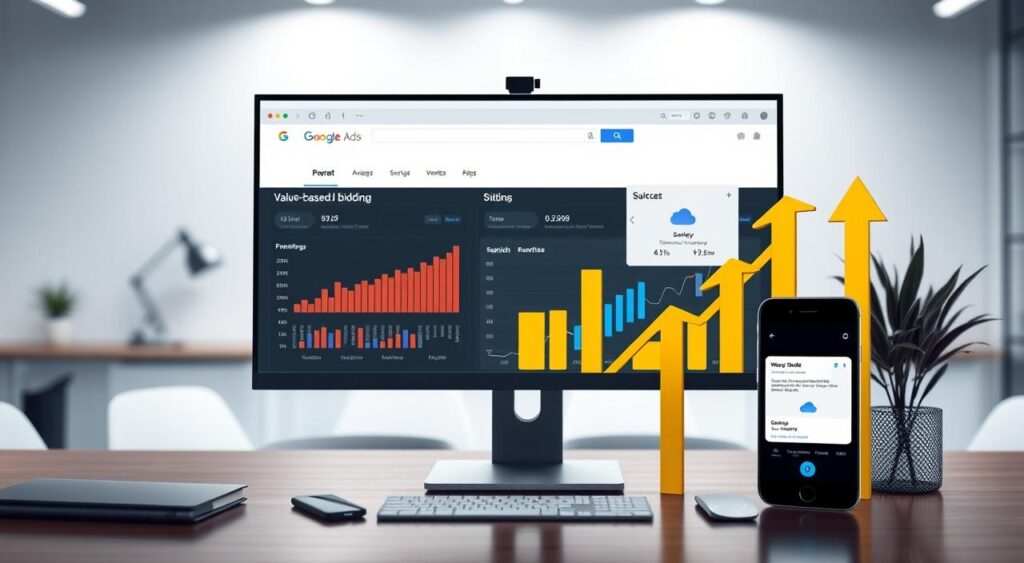If you’re into digital marketing, you’re always searching for ways to make your ads better. Value-based bidding is a strategy that’s getting a lot of attention. It matches your Google Ads bids with the real value of each conversion. In this guide, we’ll dive into how value-based bidding works and how it can boost your ad game.

Key Takeaways
- Value-based bidding focuses on optimizing bids based on the expected value of each conversion, rather than just the cost-per-click.
- This advanced bidding strategy can lead to improved return on investment (ROI) and better budget allocation for your Google Ads campaigns.
- Understanding the key components, evolution, and core principles of value-based bidding is crucial for effective implementation.
- Proper setup and ongoing optimization of value-based bidding in Google Ads are essential for maximizing its benefits.
- Monitoring relevant metrics and KPIs, as well as following best practices, can help you avoid common pitfalls and drive continued success.
Understanding the Fundamentals of Value-Based Bidding
Value-based bidding is a new way to make your digital ads work better. It’s different from old methods that just look at cost. This new approach values each ad click or view more deeply.
Key Components of Value-Based Bidding Systems
Value-based bidding has a few main parts that help it succeed. These are:
- Conversion value tracking: This tracks how much money each ad brings in.
- Audience segmentation: It groups people based on who they are and what they do.
- Bid optimization: It changes how much you pay for ads to get the best return.
- Performance monitoring: It keeps an eye on how ads are doing to find ways to get better.
The Evolution from Traditional to Value-Based Bidding
Old ways of bidding, like cost-per-click (CPC) and cost-per-impression (CPM), aren’t enough anymore. They don’t really show the real value of ads. Value-based bidding is a new way that looks at the big picture and uses data to make ads more effective.
Core Principles Behind Value-Based Strategies
Value-based bidding is based on a few key ideas. These are:
- Customer-centricity: It puts the audience first in your ad strategy.
- Data-driven decision-making: It uses lots of data to make smart choices about ads.
- Continuous improvement: It keeps getting better by always checking and tweaking the approach.
Following these ideas can help your digital ads do their best and grow your business.
How Does Value-Based Bidding Work?
The value-based bidding process in Google Ads is a powerful tool. It matches your bids with the conversion values of your campaigns. This helps you optimize your Google Ads bidding strategy to get the most return on investment (ROI).
At the heart of value-based bidding is conversion values. These are the money values of the actions or conversions that matter most to your business. For example, purchases, lead submissions, or app installs. By setting these values right, the Google Ads algorithm can optimize your bids to target the best customers and get the highest return.
The process works by always checking your campaign’s performance data. It looks at conversion rates and values. Then, it adjusts your bids to focus on the most valuable conversions. This makes sure your ad budget goes to users most likely to convert and bring in revenue for your business.
- Assign accurate conversion values: Carefully define and assign monetary values to the specific actions you want to track, such as sales, leads, or app downloads.
- Enable conversion tracking: Integrate your Google Ads account with your website or app to enable accurate conversion tracking and reporting.
- Select the appropriate bidding strategy: Choose a value-based bidding strategy, such as “Maximize Conversion Value” or “Target ROAS,” to align your bids with your conversion values.
- Monitor and optimize: Continuously monitor your campaign performance and make adjustments to your conversion values and bidding strategies as needed to optimize your results.
By using value-based bidding in your Google Ads campaigns, you can get more high-value conversions. This improves your overall ROI and makes your digital marketing strategy more efficient and effective.
“Value-based bidding is the future of effective digital advertising. By aligning your bids with your most valuable conversions, you can unlock unprecedented levels of ROI and business growth.”
Benefits of Implementing Value-Based Bidding in Your Marketing Strategy
Adding value-based bidding to your digital marketing can bring many benefits. It helps you focus on the real value of your leads and conversions. This way, you can boost your marketing ROI and make your campaigns work better.
Improved ROI and Campaign Performance
Value-based bidding lets you spend your ad budget wisely. You bid based on how much each conversion is worth. This means you get more bang for your buck and make more money.
You can focus on the leads that are most likely to bring in profits. This way, your marketing budget goes to the best opportunities.
Better Budget Allocation and Control
Value-based bidding gives you better control over your budget allocation. You can target your ads more precisely to the most valuable parts of your audience. This fine-tuning helps you use your budget more effectively.
Enhanced Target Audience Reach
Value-based bidding opens up new ways to reach your target audience. You can find and connect with the most valuable customers. This ensures your marketing is aimed at those most likely to buy and help your business grow.
“Value-based bidding is a game-changer for marketers seeking to optimize their ROI and drive more impactful campaigns. By aligning your bidding strategies with the true value of your leads, you can unlock unprecedented levels of efficiency and profitability.”
Setting Up Value-Based Bidding in Google Ads
Unlocking your marketing strategy’s full potential starts with value-based bidding in Google Ads. This feature lets you focus on the real value of each conversion, not just the cost-per-click.
To begin, set up your conversion tracking and value each action that’s important to your business. This could be purchases, lead submissions, or other key user interactions. By accurately showing the value of these conversions, you can set up your bidding to focus on the most impactful actions.
- Enable conversion tracking in your Google Ads account to capture critical data on user actions and their associated values.
- Assign monetary values to your conversions, reflecting their true worth to your business. This information will fuel your value-based bidding efforts.
- Select the appropriate bidding strategy, such as Target CPA or Target ROAS, to align your bids with your value-based objectives.
By integrating value-based bidding into your Google Ads, you can boost your campaign’s performance and profits. This approach helps you make better decisions, use your budget wisely, and target the most valuable audiences for your brand.
| Step | Action | Impact |
|---|---|---|
| 1 | Enable conversion tracking | Capture critical data on user actions and their associated values |
| 2 | Assign monetary values to conversions | Reflect the true worth of user actions to your business |
| 3 | Select value-based bidding strategy | Align your bids with your value-based objectives |
Embrace the power of value-based bidding in Google Ads and unlock a new era of campaign optimization and success.

Common Value-Based Bidding Metrics and KPIs
Understanding value-based bidding means knowing the key performance indicators (KPIs) and metrics that matter. These include tracking conversion values and analyzing data for optimization. These measurements are crucial for your campaign’s success.
Conversion Value and Revenue Tracking
At the core of value-based bidding is measuring the true value of conversions. By tracking conversion value and revenue, you learn about your campaigns’ financial impact. This knowledge helps you make smart decisions to boost your ROI.
Performance Indicators and Success Measures
Value-based bidding goes beyond just tracking conversions. It also needs performance indicators and success measures to judge your strategy’s success. Metrics like cost-per-conversion, conversion rate, and average order value give a full view of your campaign’s performance. They help you find areas to improve.
Data Analysis and Optimization Methods
Data analysis is key in value-based bidding. It helps you find hidden insights, trends, and make decisions to optimize your campaigns. From A/B testing to audience segmentation, the right analysis can open up new opportunities for your marketing.
| Metric | Description | Relevance to Value-Based Bidding |
|---|---|---|
| Conversion Value | The monetary value of a conversion, like a sale or lead. | Essential for measuring your campaigns’ financial impact and guiding your bidding. |
| Revenue Tracking | Monitoring and reporting on the revenue from your marketing. | Helps you see the true ROI and make better budget decisions. |
| Cost-per-Conversion | The average cost for each successful conversion. | Shows how efficient your bidding strategy is and where to improve. |
| Conversion Rate | The percentage of visitors or ad clicks that convert. | Shows how well your targeting and messaging work, guiding your bidding. |
| Average Order Value | The average value of each transaction or conversion. | Key for setting accurate bid values and maximizing your bidding investments. |
By using these common value-based bidding metrics and KPIs, you gain a deeper understanding of your campaign’s performance. This knowledge helps you make better decisions and drive growth through your marketing.
Best Practices for Value-Based Bidding Optimization
To make your value-based bidding campaigns work best, you need a smart plan. When you start with bidding optimization, remember a few key tips. These strategies will help you get the most out of your value-based strategies and improve your performance greatly.
- Keep a close eye on your important performance indicators (KPIs). Watch things like conversion value, return on ad spend (ROAS), and cost per acquisition. This helps you see where you can get better.
- Always update your bidding algorithms and change your bids based on what your data shows. Stay flexible to keep up with market changes and what people want.
- Use audience segmentation and personalization to make your value-based bidding better. Know what your audience likes and adjust your bids to meet their needs.
- Set up a strong testing and experimenting plan. Try out different bidding methods, ad types, and targeting to find what works best for your goals.
- Keep improving your ad creatives and landing pages to make the user experience better. Make sure your ads and landing pages match your value-based bidding goals.
| Metric | Benchmark | Your Performance | Improvement Potential |
|---|---|---|---|
| Conversion Value | $25,000 | $18,000 | 28% increase |
| ROAS | 5.2x | 3.9x | 33% improvement |
| Cost per Acquisition | $35 | $42 | 17% reduction |
By following these best practices and always improving your value-based bidding strategies, you can reach new heights in campaign performance. This will help your business grow in a lasting way.

“Effective value-based bidding optimization is the key to unlocking the full potential of your marketing campaigns.”
Avoiding Common Pitfalls in Value-Based Bidding
Value-based bidding can change your marketing game, but it comes with its own set of challenges. To make the transition smooth and successful, it’s key to tackle common issues and find solutions. Let’s look at three main areas where advertisers often struggle and find ways to overcome them.
Read More: What is the difference between Google Ads and DV360?
Technical Challenges and Solutions
Setting up the right tracking and data infrastructure is a big hurdle in value-based bidding. Getting accurate conversion value reports and making sure they work well with your bid management platform can be tough. Look for help from experts or use automated tools to make the setup easier and reduce data errors.
Strategy Adjustment and Fine-tuning
Value-based bidding needs a more detailed and flexible approach than traditional methods. You must regularly check your performance, tweak bids, and refine your targeting and messages. Be ready to try new things, analyze results, and keep improving your strategy.
Performance Monitoring and Troubleshooting
Keeping a close eye on your performance is vital with value-based bidding. Watch metrics like conversion value, return on ad spend (ROAS), and customer lifetime value (CLV) to spot problems or areas for betterment. Act quickly to fix any issues or unexpected changes to keep your strategy on track.
By tackling these common issues and using the right strategies, you can fully benefit from value-based bidding. It’s a journey of ongoing learning and improvement. Remember, successful value-based bidding is a journey of continuous learning and refinement.
Conclusion
Value-based bidding is a game-changer for digital marketing. It helps you focus on the real value of each conversion. This way, you can make your ads work harder for you, leading to better results.
Using value-based bidding brings many benefits. You’ll see your ROI improve and your budget used more wisely. It also helps you reach the right people with your ads.
This strategy isn’t a quick fix. It needs careful thought, data, and constant improvement. But the benefits are huge. By using value-based bidding, you’ll become a smarter, more effective advertiser. This will help your business grow over time.
FAQ
How does value-based bidding work?
Value-based bidding is a smart way to advertise. You set bids based on how much each conversion is worth. This means your bids change to get the best return on investment.
How does value-based bidding work in Google Ads?
In Google Ads, you bid based on conversion value. The system aims to get the most value from your conversions. This way, you spend more on the most valuable customers.
What are the benefits of using value-based bidding?
Value-based bidding boosts your ROI and helps you spend wisely. It also lets you reach more valuable customers. This makes your marketing dollars go further.
How do I set up value-based bidding in Google Ads?
To start, make sure you have conversion tracking set up. Then, pick a bidding strategy like Target ROAS. Finally, adjust your bids to fit your goals and audience.
What are the key metrics and KPIs for value-based bidding?
Important metrics include conversion value and ROAS. Also, look at CPA and CPC. These help you see if your bidding is working well.
What are some best practices for optimizing value-based bidding?
To improve, regularly check your conversion values. Adjust bids and budgets as needed. Test different strategies and target your best customers. Always keep an eye on your campaigns to make smart decisions.
𝐒𝐰𝐚𝐠𝐚𝐭 𝐆𝐚𝐰𝐚𝐝𝐞
Digital Marketer | Content Creator | Growth Strategist
With 2 years of hands-on experience in the dynamic world of digital marketing, Swagat Gawade specializes in crafting compelling strategies that drive growth and engagement. From managing ad campaigns to optimizing SEO, Swagat has a proven track record of boosting brand visibility and achieving measurable results.
Key skills:
𝐒𝐨𝐜𝐢𝐚𝐥 𝐌𝐞𝐝𝐢𝐚 𝐌𝐚𝐫𝐤𝐞𝐭𝐢𝐧𝐠: Building impactful campaigns that resonate with audiences.
𝐂𝐨𝐧𝐭𝐞𝐧𝐭 𝐌𝐚𝐫𝐤𝐞𝐭𝐢𝐧𝐠: Creating engaging, high-quality content tailored to target markets.
𝐒𝐄𝐎 & 𝐒𝐄𝐌 𝐄𝐱𝐩𝐞𝐫𝐭𝐢𝐬𝐞: Ensuring brands rank high and stay competitive in search results.
𝐀𝐧𝐚𝐥𝐲𝐭𝐢𝐜𝐬 𝐏𝐫𝐨𝐟𝐢𝐜𝐢𝐞𝐧𝐜𝐲: Leveraging data to refine strategies and enhance ROI.
Swagat’s passion for learning fuels a constant pursuit of innovative marketing solutions, making him a valuable asset in today’s fast-evolving digital landscape.


